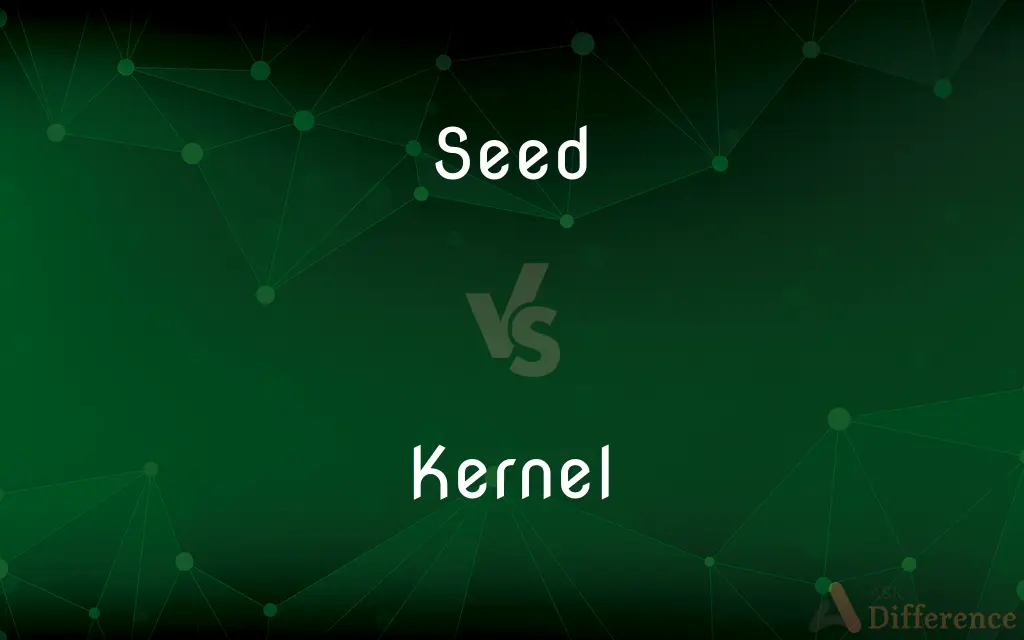Seed vs. Kernel — What's the Difference?
By Urooj Arif & Maham Liaqat — Updated on February 29, 2024
A seed is a plant's reproductive unit capable of developing into another plant, while a kernel is the edible part inside a seed or nut, often referring specifically to grains.

Difference Between Seed and Kernel
Table of Contents
ADVERTISEMENT
Key Differences
Seeds serve as the reproductive units of flowering plants (angiosperms) and conifers (gymnosperms), containing the embryo that can grow into a new plant. They are encased in a protective outer covering and can vary widely in size, shape, and color depending on the species. Kernels, on the other hand, refer to the inner, edible part of a seed, nut, or fruit stone. In the context of grains like wheat, corn, or barley, the kernel is the whole seed itself, but in culinary and commercial contexts, it often specifically denotes the softer, digestible part inside the hard outer shell of nuts or seeds.
Seeds are fundamental to plant propagation, containing the genetic information necessary for the continuation of plant species. Kernels are rich in nutrients, including carbohydrates, fats, proteins, vitamins, and minerals, making them an important food source for humans and animals.
The distinction between a seed and a kernel is important in various fields, including botany, agriculture, and nutrition. While all kernels can be considered seeds (in the case of grains), not all seeds are referred to as kernels, especially when the seed is not used for human consumption or when the entire seed is not edible.
The focus on seeds encompasses their role in plant growth and propagation. Meanwhile, in food science and nutrition, kernels are often discussed in terms of their health benefits and culinary uses. Kernels extracted from seeds are used in a wide array of products, including cooking oils, snacks, and baking ingredients.
Understanding the biology of seeds and kernels is crucial for crop production, breeding, and the development of sustainable food sources. The study of seeds, including their dormancy, germination, and storage, is essential for agriculture, while the nutritional analysis of kernels contributes to food science and dietary recommendations.
ADVERTISEMENT
Comparison Chart
Definition
A plant's reproductive unit, capable of developing into a new plant.
The edible part inside a seed, nut, or grain.
Role
Propagation of plant species.
Often used as a food source.
Composition
Contains an embryo and, typically, a store of nutrients, encased in a protective outer layer.
The inner, often edible part, rich in nutrients.
Contexts
Botany, agriculture, gardening.
Food science, nutrition, culinary arts.
Examples
Seeds of fruits, vegetables, flowers.
Wheat kernels, corn kernels, nut kernels.
Compare with Definitions
Seed
Contains an embryo.
Inside each seed is an embryo that can grow into a new plant.
Kernel
Rich in nutrients.
Almond kernels are a good source of healthy fats and protein.
Seed
Varies in size and shape.
Seeds range from tiny orchid seeds to large coconut seeds.
Kernel
Edible part of a seed.
The kernel of corn is what we eat as popcorn.
Seed
Encased in a protective layer.
The seed's outer coating protects it from harsh environmental conditions.
Kernel
Used in culinary arts.
Kernels from various seeds are used in cooking and baking.
Seed
Fundamental for plant propagation.
Seeds ensure the continuation of plant species.
Kernel
Often refers to grains.
Barley kernels are used in brewing beer.
Seed
Plant reproductive unit.
The gardener planted tomato seeds in the spring.
Kernel
Inside grains and nuts.
Wheat kernels are ground into flour for baking.
Seed
A seed is an embryonic plant enclosed in a protective outer covering. The formation of the seed is part of the process of reproduction in seed plants, the spermatophytes, including the gymnosperm and angiosperm plants.
Kernel
A softer, usually edible part of a nut, seed, or fruit stone contained within its shell
The kernel of a walnut
Pine kernels
Seed
A mature plant ovule containing an embryo.
Kernel
The central or most important part of something
This is the kernel of the argument
Seed
A small dry fruit, spore, or other propagative plant part.
Kernel
A grain or seed, as of a cereal grass, enclosed in a husk.
Seed
Seeds considered as a group
A farmer buying seed.
Kernel
The usually edible seed inside the hard covering of a nut or fruit stone.
Seed
The seed-bearing stage of a plant
The grass is in seed.
Kernel
The inner and usually edible part of a seed or grain or nut or fruit stone;
Black walnut kernels are difficult to get out of the shell
Seed
To sow seed.
Kernel
A single whole grain of a cereal;
A kernel of corn
Seed
To shed the seed.
Seed
Remove the seeds from;
Seed grapes
Common Curiosities
Are kernels only found in grains?
While commonly associated with grains, kernels can also refer to the edible parts inside nuts and seeds.
What is a seed?
A seed is a plant's reproductive unit, containing the embryo and nutrients needed for it to grow into a new plant.
Can all seeds be eaten?
Not all seeds are edible for humans; some are toxic, while others are simply too hard to consume.
What nutritional value do kernels have?
Kernels are often rich in carbohydrates, fats, proteins, vitamins, and minerals, making them an important part of the diet.
What is a kernel?
A kernel is the inner, edible part of a seed, nut, or grain, often rich in nutrients.
How does a seed differ from a kernel?
A seed is the whole reproductive unit of a plant, while a kernel specifically refers to the edible inner part of a seed, nut, or grain.
Why are seeds important in agriculture?
Seeds are crucial for plant propagation, crop production, and breeding new plant varieties.
What role do seeds play in the ecosystem?
Seeds are vital for the reproduction of plant species, supporting biodiversity and various food webs.
How are kernels used in food production?
Kernels are used in a variety of food products, including oils, flours, snacks, and as ingredients in cooking and baking.
How are seeds and kernels preserved for long periods?
Seeds and kernels are dried and stored in cool, dry conditions to prolong their viability and prevent spoilage.
Share Your Discovery

Previous Comparison
Joint vs. Junction
Next Comparison
Break vs. ShatterAuthor Spotlight
Written by
Urooj ArifUrooj is a skilled content writer at Ask Difference, known for her exceptional ability to simplify complex topics into engaging and informative content. With a passion for research and a flair for clear, concise writing, she consistently delivers articles that resonate with our diverse audience.
Co-written by
Maham Liaqat















































